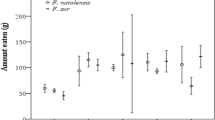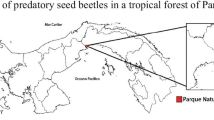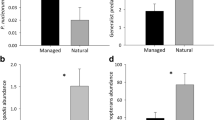Abstract
Fruit-eating animals can influence the germination success of seeds through transportation and handling. We experimentally tested the contribution of ingestion by the common fruit-eating bat, Artibeus jamaicensis (Phyllostomidae, Chiroptera), to the percentage and rate of seed germination of figs (Ficus, Moraceae), which are considered keystone species for many frugivores. We collected fruits from three species of native free-standing figs (subgenus Pharmacosycea: F. insipida, F. maxima and F. yoponensis) and three species of native strangler figs (subgenus Urostigma: F. nymphiifolia, F. obtusifolia and F. popenoei) on Barro Colorado Island, Panama. The germination success of seeds removed from fruit pulp either manually or by ingestion was very high (>92%), while seeds that were not removed from fruit pulp were destroyed by fast-growing fungi within a few days. The dynamics of seed germination were not influenced by ingestion, but differed between the two subgenera of figs. In free-standing figs, germination started significantly earlier (5.3 ± 0.7 days) than in strangler figs (8.6 ± 1.4 days). Furthermore, strangler seeds were covered with a sticky coating and their seedlings developed cotyledons faster than fine roots, in contrast to free-standing figs that showed the opposite pattern. Our results demonstrate that the germination of fig seeds is positively influenced by passage through the gut of A. jamaicensis. Furthermore, free-standing and strangler figs revealed differences in germination parameters that might be adaptive with respect to the suitability of microsites such as tree fall gaps or host trees for establishment.






Similar content being viewed by others
References
August PV (1981) Fig fruit consumption and seed dispersal by Artibeus jamaicensis in the Llanos of Venezuela. Biotropica 13:70–76
Banack SA, Horn MH, Gawiicka A (2002) Disperser- vs. establishment-limited distribution of a riparian fig tree (Ficus insipida) in a Costa Rican tropical rain forest. Biotropica 34:232–243
Bernard E, Fenton MB (2002) Species diversity of bats (Mammalia: Chiroptera) in forest fragments, primary forests, and savannas in central Amazonia, Brazil. Can J Zool 80:1124–1140
Bleher B, Potgieter CJ, Johnson DN, Böhning-Gaese K (2003) The importance of figs for frugivores in a South African coastal forest. J Trop Ecol 19:375–386
Bonaccorso FJ, Gush TJ (1987) Feeding behaviour and foraging strategies of captive phyllostomid fruit bats: an experimental study. J Anim Ecol 56:907–920
Brown RF, Mayer DG (1988) Representing cumulative germination 1. A critical analysis of single-value germination indices. Ann Bot (Lond) 61:117
Bustamante RO, Canals M (1995) Dispersal quality in plants: how to measure efficiency and effectiveness of a seed disperser. Oikos 73:133–136
de Figueiredo RA (1993) Ingestion of Ficus enormis seeds by howler monkeys (Alouatta fusca) in Brazil: effects on seed germination. J Trop Ecol 9:541–543
Djossa BA, Fahr J, Kalko EKV, Sinsin BA (2008) Fruit selection and effects of seed handling by flying foxes on germination of shea trees, a key resource in Northern Benin, West Africa. Ecotropica 14:37–48
Giannini NP, Kalko EKV (2004) Trophic structure in a large assemblage of phyllostomid bats in Panama. Oikos 105:209–220
Griscom HP, Kalko EKV, Ashton MS (2007) Frugivory by small vertebrates within a deforested, dry tropical region of Central America. Biotropica 39:278–282
Handley CO Jr, Wilson DE, Gardner AL (1991) Demography and natural history of the common fruit bat, Artibeus jamaicensis, on Barro Colorado Island, Panama. Smithsonian Contributions to Zoology, vol 511, 173pp
Henry M, Jouard S (2007) Effect of bat exclusion on patterns of seed rain in tropical rain forest in French Guiana. Biotropica 39:510–518
Herre EA (1996) An overview of studies on a community of Panamanian figs. J Biogeogr 23:593–607
Hodgkison R, Balding ST, Zubaid A, Kunz TH (2003) Fruit bats (Chiroptera: Pteropodidae) as seed dispersers and pollinators in a lowland Malaysian rain forest. Biotropica 35:491–502
Holm S (1979) A simple sequentially rejective multiple test procedure. Scand J Statist 6:65–70
Howe HF, Smallwood J (1982) Ecology of seed dispersal. Annu Rev Ecol Syst 13:201–228
Izhaki I, Korine C, Arad Z (1995) The effect of bat (Rousettus aegyptiacus) dispersal on seed germination in eastern Mediterranean habitats. Oecologia 101:335–342
Janzen DH (1970) Herbivores and the number of tree species in tropical forests. Am Nat 104:501–528
Janzen DH (1979) How to be a fig. Annu Rev Ecol Syst 10:13–51
Kalko EKV, Handley CO Jr (2001) Neotropical bats in the canopy: diversity, community structure, and implications for conservation. Plant Ecol 153:319–333
Kalko EKV, Herre EA, Handley CO Jr (1996) Relation of fig fruit characteristics to fruit-eating bats in the New and Old World tropics. J Biogeogr 23:565–576
Kelm DH, Wiesner KR, von Helversen O (2008) Effects of artificial roosts for frugivorous bats on seed dispersal in a Neotropical forest pasture mosaic. Conserv Biol 22:733–741
Korine C, Kalko EKV, Herre EA (2000) Fruit characteristics and factors affecting fruit removal in a Panamanian community of strangler figs. Oecologia 123:560–568
Laman TG (1995) Ficus stupenda germination and seedling establishment in a Bornean rain forest canopy. Ecology 76:2617–2626
Laska M (1990) Food transit times and carbohydrate use in three phyllostomid bat species. Z Säugetierk 55:49–54
Link A, Fiore AD (2006) Seed dispersal by spider monkeys and its importance in the maintenance of neotropical rain-forest diversity. J Trop Ecol 22:235–246
Lopez JE, Vaughan C (2004) Observations on the role of frugivorous bats as seed dispersers in Costa Rican secondary humid forests. Acta Chiropt 6:111–119
Melo FPL, Rodriguez-Herrera B, Chazdon RL, Medellin RA, Ceballos GG (2009) Small tent-roosting bats promote dispersal of large-seeded plants in a Neotropical forest. Biotropica 41:737–743
Meyer CFJ, Kalko EKV (2008) Assemblage-level responses of phyllostomid bats to tropical forest fragmentation: land-bridge islands as a model system. J Biogeogr 35:1711–1726
Morrison DW (1978a) Foraging ecology and energetics of the frugivorous bat Artibeus jamaicensis. Ecology 59:716–723
Morrison DW (1978b) Influence of habitat on the foraging distances of the fruit bat, Artibeus jamaicensis. J Mammal 59:622–624
Morrison DW (1980) Efficiency of food utilization by fruit bats. Oecologia 45:270–273
Muscarella R, Fleming TH (2007) The role of frugivorous bats in tropical forest succession. Biol Rev 82:573–590
Nason JD, Herre EA, Hamrick JL (1998) The breeding structure of a tropical keystone plant resource. Nature 391:685–687
Nogueira MR, Peracchi AL (2003) Fig-seed predation by 2 species of Chiroderma: discovery of a new feeding strategy in bats. J Mammal 84:225–233
Ortega J, Castro-Arellano I (2001) Artibeus jamaicensis Leach, 1821: Jamaican fruit-eating bat. Mamm Species 662:1–9
Peters HA (2003) Neighbour-regulated mortality: the influence of positive and negative density dependence on tree populations in species-rich tropical forests. Ecol Lett 6:757–765
Reiter J (2002) Differential ingestion of Ficus seeds by frugivorous bats: a first experimental test in Ptenochirus jagori (Pteropodidae). Acta Chiropt 4:99–102
Righini N, Serio-Silva JC, Rico-Gray V, Martínez-Mota R (2004) Effect of different primate species on germination of Ficus (Urostigma) seeds. Zoo Biol 23:273–278
Robertson AW, Trass A, Ladley JJ, Kelly D (2006) Assessing the benefits of frugivory for seed germination: the importance of the deinhibition effect. Funct Ecol 20:58–66
Samuels IA, Levey DJ (2005) Effects of gut passage on seed germination: do experiments answer the questions they ask? Funct Ecol 19:365–368
Schupp EW (1993) Quantity, quality and the effectiveness of seed dispersal by animals. Vegetatio 107–108:15
Shanahan M, So S, Compton SG, Corlett R (2001) Fig-eating by vertebrate frugivores: a global review. Biol Rev 76:529–572
Shilton LA, Altringham JD, Compton SG, Whittaker RJ (1999) Old World fruit bats can be long-distance seed dispersers through extended retention of viable seeds in the gut. Proc R Soc Lond B Biol Sci 266:219–223
Swagel EN, Bernhard AvH, Ellmore GS (1997) Substrate water potential constraints on germination of the strangler fig Ficus aurea (Moraceae). Am J Bot 84:716–722
Tang Z-H, Mukherjee A, Sheng L-X, Cao M, Liang B, Corlett RT, Zhang S-Y (2007) Effect of ingestion by two frugivorous bat species on the seed germination of Ficus racemosa and F. hispida (Moraceae). J Trop Ecol 23:125–127
Teixeira RC, Correa CE, Fischer E (2009) Frugivory by Artibeus jamaicensis (Phyllostomidae) bats in the Pantanal, Brazil. Stud Neotrop Fauna Environ 44:7–15
Traveset A (1998) Effect of seed passage through vertebrate frugivores’ guts on germination: a review. Perspect Plant Ecol Evol Syst 1/2:151–190
Traveset A, Rodriguez-Perez J, Pias B (2008) Seed trait changes in dispersers’ guts and consequences for germination and seedling growth. Ecology 89:95–106
Utzurrum RCB, Heideman PD (1991) Differential ingestion of viable vs nonviable Ficus seeds by fruit bats. Biotropica 23:311–312
Wang BC, Smith TB (2002) Closing the seed dispersal loop. Trends Ecol Evol 17:379–385
Wenny DG (2001) Advantages of seed dispersal: a re-evaluation of directed dispersal. Evol Ecol Res 3:51–74
Acknowledgments
This work was supported by a DAAD (German Academic Exchange Service) fellowship to K. Heer. We thank the Smithsonian Tropical Research Institute (STRI) in Panama for logistic support. We particularly thank Robert Hodgkison, Sonja Gässler and Kathrin Barboza-Marquez for help in the field. We also want to thank two anonymous reviewers for their helpful comments that considerably improved our manuscript. Animal capture and treatment comply with the current laws of Panama and have been approved by the Animal Care Committee of the Smithsonian Tropical Research Institute.
Author information
Authors and Affiliations
Corresponding author
Additional information
Communicated by Mark Chappell.
Rights and permissions
About this article
Cite this article
Heer, K., Albrecht, L. & Kalko, E.K.V. Effects of ingestion by neotropical bats on germination parameters of native free-standing and strangler figs (Ficus sp., Moraceae). Oecologia 163, 425–435 (2010). https://doi.org/10.1007/s00442-010-1600-x
Received:
Accepted:
Published:
Issue Date:
DOI: https://doi.org/10.1007/s00442-010-1600-x




